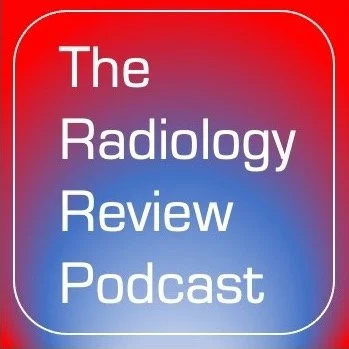Neuroradiology: Cranial Foramina
Review of neuroradiology cranial foramina for radiology board exams. Check out the free study guide by clicking here.
Show Notes/Study Guide:
What are the typical nerve and arterial contents of the foramen ovale?
Trigeminal nerve, mandibular division (V3)
Inferior otic ganglion
Lesser petrosal nerve
Sometimes meningeal branch of mandibular nerve/nervus spinosus (this more commonly passes through the foramen spinosum)
Accessory meningeal artery
If you add the veins, there is a mnemonic of OVALE:
Otic ganglion
V3
Accessory meningeal artery
Lesser petrosal nerve
Emissary veins
What are the typical nerve and arterial contents of the foramen spinosum?
Middle meningeal artery
Meningeal branch of mandibular nerve/nervus spinosus (most of the time)
What are the typical nerve and arterial contents of the foramen rotundum?
Trigeminal nerve, maxillary branch (V2)
Artery of the foramen rotundum
Remember: V2 passes through the foramen rotundum and V3 passes through the foramen ovale. A stupid trick that helps me remember this is “rotwondum” to help me remember Vtwo passes through the foramen of rotundum.
What are the typical nerve, arterial, and venous contents of the superior orbital fissure?
Nerve: trochlear nerve, abducens nerve, oculomotor nerve, as well as the lacrimal, frontal, and nasociliary nerves.
Arterial: none
Veins: superior and inferior ophthalmic vein branches
What are the osseous boundaries of the superior orbital fissure?
Superior: lesser wing of sphenoid
Inferior: greater wing of sphenoid
Medial: sphenoid bone
Lateral: frontal bone
What are the typical nerve, arterial, and venous contents of the inferior orbital fissure?
Nerve: infraorbital nerve, zygomatic nerve, orbital branches of pterygopalatine ganglion
Artery: infraorbital artery
Vein: inferior ophthalmic vein branch(es)
What are the typical contents of the optic canal?
The ophthalmic artery and optic nerve
True or false? The internal carotid artery passes through the foramen lacerum.
False. The internal carotid artery passes by the superior aspect of the foramen lacerum (which is termed the lacerum segment of the internal carotid artery) but it does not traverse through the foramen lacerum.
What are the typical nerve and arterial contents of the foramen lacerum?
Ascending pharyngeal artery branches and the greater petrosal nerve/deep petrosal nerve which merge and then exit as the nerve of the pterygoid canal.
Through which opening does the internal carotid artery enter the skull base?
Through the carotid canal.
What are the typical contents of the supraorbital foramen?
The appropriately named supraorbital artery, vein, and nerve.
What are the typical contents of the infraorbital foramen?
The appropriately named infraorbital artery, vein, and nerve. Note that the infraorbital nerve then gives off the superior alveolar nerves.
What are the typical nerve and arterial contents of the pterygoid canal?
The Vidian nerve and Vidian artery. Note that the pterygoid canal is also called the Vidian canal.
What are the typical nerve and arterial contents of the stylomastoid foramen?
The facial nerve and the stylomastoid artery.
What are the typical nerve and vascular contents of the jugular foramen?
The glossopharyngeal, vagus, and accessory nerves and portions of the jugular bulb/internal jugular vein.
What are the typical nerve and arterial contents of the internal auditory canal?
The facial nerve, vestibulocochlear nerve, vestibular ganglion, and the labyrinthine artery. Sometimes board exams expect you to know how the nerves are positioned within the internal auditory canal. A mnemonic that can help with this is “Seven Up. Coke Down.” Meaning that the facial nerve (7th cranial nerve) is superior, and the cochlear nerve is inferior in the canal.
What are the typical nerve and arterial contents of the foramen magnum?
The medulla oblongata, the accessory nerve spinal root (entering through foramen magnum), the vertebral and anterior and posterior spinal arteries.
How does the hypoglossal nerve exit the cranium?
Through the hypoglossal canal.
Through which foramina do the V1, V2, and V3 branches of the trigeminal nerve exit the skull?
V1: superior orbital fissure
V2: foramen rotundum
V3: foramen ovale
Summary on cranial nerves and associated foramina:
Cranial Nerve #
Name
Exit from Skull
CN1
Olfactory nerve
Cribriform plate
CN2
Optic nerve
Optic foramen
CN3
Oculomotor nerve
Superior orbital fissure
CN4
Trochlear nerve
Superior orbital fissure
CN5
Trigeminal nerve
V1 (Ophthalmic): Superior orbital fissure
V2 (Maxillary): foramen rotundum
V3 (Mandibular): foramen ovale
CN6
Abducens nerve
Superior orbital fissure
CN7
Facial nerve
Stylomastoid foramen
CN8
Vestibulocochlear nerve
Internal auditory canal
CN9
Glossopharyngeal nerve
Jugular foramen
CN10
Vagus nerve
Jugular foramen
CN11
Accessory nerve
Jugular foramen (spinal root branches ascent through foramen magnum and then exit jugular foramen)
CN12
Hypoglossal nerve
Hypoglossal canal
Bonus: What is my favorite mnemonic to remember the cranial nerves in order? For fans of a certain book/movie series: On, On, On, They Traveled And Found Voldemort Guarding Very Ancient Horcruxes. I did not create this. It is all over online. This is great for those who know the stories.
What is the Dorello canal?
Canal that allows the abducens nerve to traverse between the pontine cistern and cavernous sinus.
What is the typical clinical significance of the sphenopalatine foramen?
For radiology board exams, consider this as a potential pathway for perineural spread from the nasal cavity/superior nasal meatus to the pterygopalatine fossa.
What are the typical nerve and vascular contents of the sphenopalatine foramen?
Nerves: nasopalatine nerve and posterior superior nasal nerve
Vascular: sphenopalatine artery and sphenopalatine vein.





